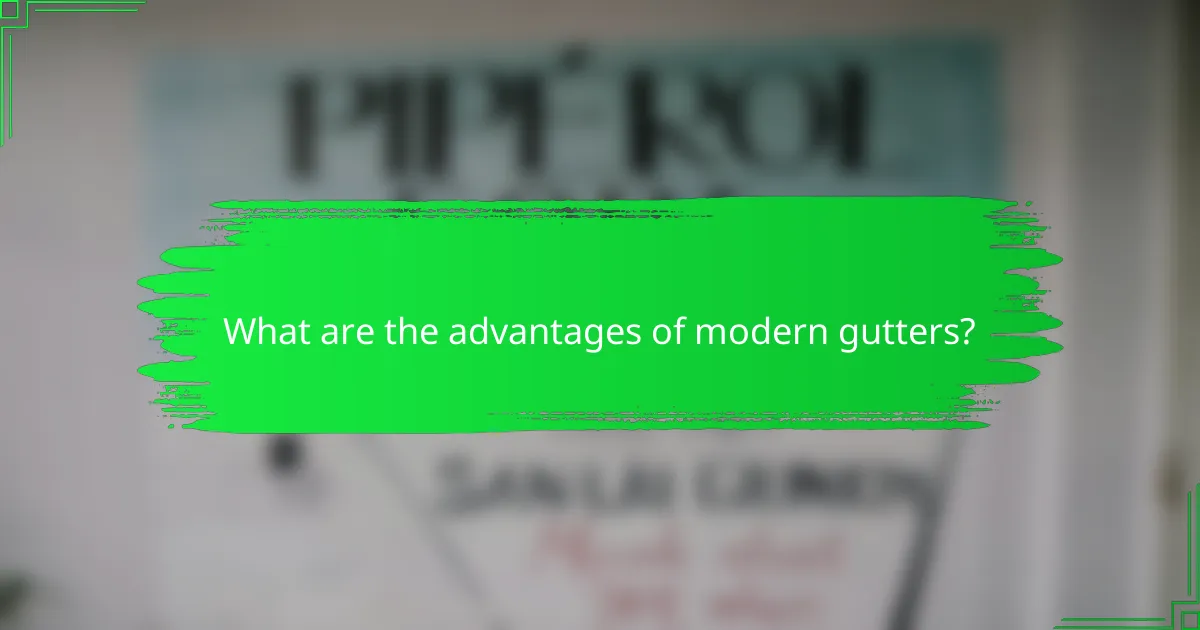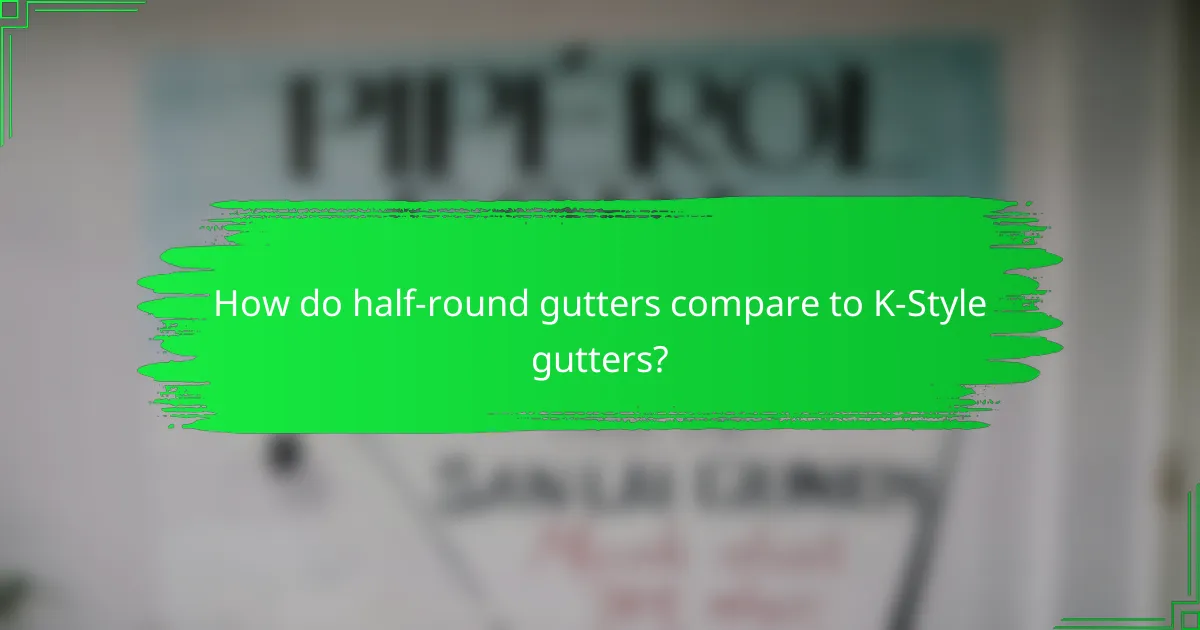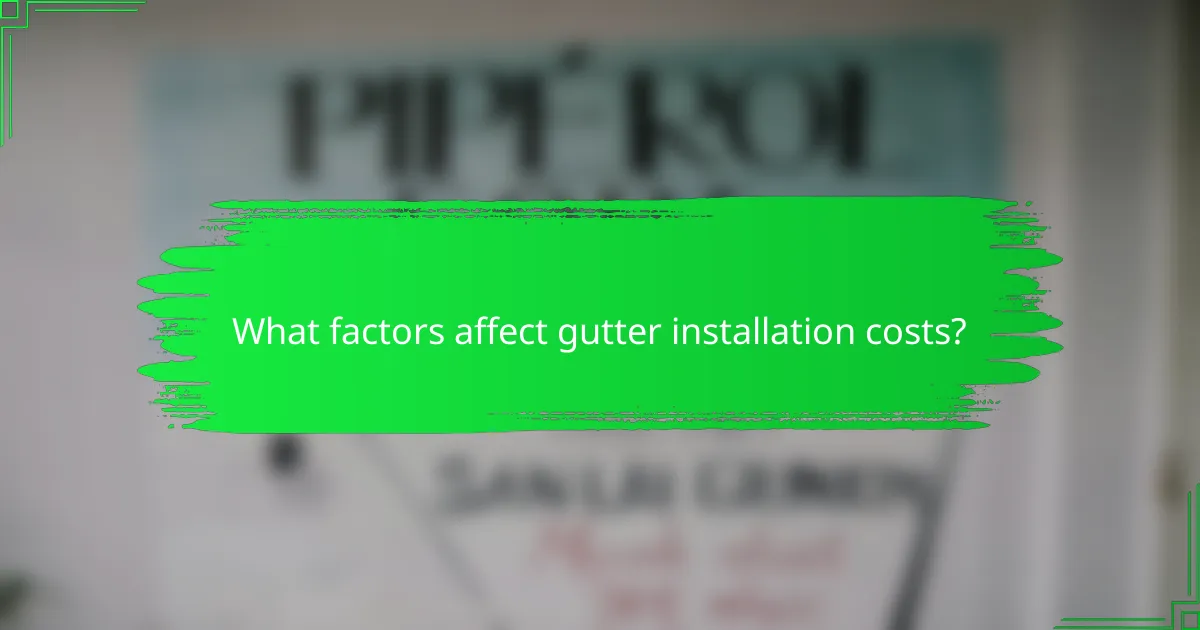When selecting gutters for your home, it’s important to consider styles such as traditional, modern, half-round, and K-style, each offering distinct advantages. These styles not only influence the functionality and maintenance of your drainage system but also enhance your home’s aesthetic appeal. Understanding the unique characteristics of each option can help you make an informed choice that aligns with your architectural design and local climate.

What are the best gutter styles for homes in the United States?
The best gutter styles for homes in the United States include traditional, modern, half-round, and K-style gutters. Each style has unique characteristics that affect functionality, aesthetics, and maintenance, making it essential to choose the right one for your home.
Traditional gutter styles
Traditional gutter styles typically refer to the classic designs that have been used for decades, such as box gutters. These gutters are usually made from materials like wood or metal and are often integrated into the roofline for a seamless look.
When considering traditional gutters, think about their maintenance requirements. Wood gutters, for instance, may require regular painting and sealing to prevent rot, while metal options can be more durable but may still need occasional upkeep.
Modern gutter styles
Modern gutter styles emphasize sleek lines and minimalistic designs, often using materials like vinyl or aluminum. These gutters are designed to blend seamlessly with contemporary architecture and are generally easier to install and maintain.
Homeowners should consider the durability and color options available with modern gutters. Vinyl gutters, for example, are lightweight and resistant to rust, while aluminum options can be painted to match the home’s exterior.
Half-Round gutter styles
Half-round gutter styles are characterized by their semi-circular shape, which allows for efficient water flow and reduced debris accumulation. This style is often seen in historic homes but can also complement modern designs.
While half-round gutters can be aesthetically pleasing, they may require additional brackets for support, especially in areas with heavy rainfall. It’s crucial to ensure proper installation to prevent sagging or leaks.
K-Style gutter styles
K-Style gutters are among the most popular options in the United States, featuring a flat bottom and a decorative front that resembles crown molding. They are available in various materials, including vinyl, aluminum, and steel.
These gutters are designed to handle a significant volume of water, making them suitable for regions with heavy rainfall. Homeowners should consider the size and pitch of their roof when selecting K-Style gutters to ensure optimal performance.

How do I choose the right gutter style for my home?
Choosing the right gutter style for your home involves considering your architectural design, local climate, and maintenance preferences. Each gutter style offers unique benefits and aesthetic qualities that can enhance your home’s functionality and appearance.
Consider architectural style
Your home’s architectural style plays a significant role in determining the most suitable gutter style. Traditional homes often benefit from half-round gutters, which provide a classic look, while modern designs may pair well with K-style gutters that offer a sleek, contemporary appearance.
When selecting a gutter style, ensure it complements your home’s overall design. For instance, a Victorian house might look best with ornate half-round gutters, while a minimalist structure could be enhanced by the clean lines of K-style gutters.
Evaluate climate conditions
Climate conditions significantly impact gutter performance and durability. In areas with heavy rainfall or snow, K-style gutters are often preferred due to their larger capacity for water flow. Conversely, half-round gutters may be more suitable for regions with lighter precipitation.
Consider local weather patterns when choosing a gutter style. For example, if you live in a region prone to ice dams, selecting a style that allows for efficient drainage and minimizes water pooling is crucial.
Assess maintenance requirements
Different gutter styles come with varying maintenance needs. K-style gutters typically require less frequent cleaning due to their design, which helps prevent debris accumulation. In contrast, half-round gutters may necessitate more regular maintenance to ensure proper water flow.
When assessing maintenance, think about your willingness to perform upkeep tasks. If you prefer a low-maintenance option, K-style gutters might be the better choice, while those who enjoy hands-on home care may appreciate the charm of half-round gutters despite the extra work involved.

What are the benefits of traditional gutters?
Traditional gutters offer several advantages, including their classic design that enhances the overall look of a home and their robust construction that ensures long-term performance. These gutters are often favored for their timeless appeal and ability to withstand various weather conditions.
Classic aesthetic appeal
Traditional gutters are designed to complement older architectural styles, making them a popular choice for historic homes or those aiming for a vintage look. Their elegant lines and finishes can significantly enhance curb appeal, providing a cohesive look that blends well with classic roofing styles.
Homeowners often choose materials like copper or aluminum for traditional gutters, which can be painted or left in their natural state to match the home’s exterior. This versatility allows for customization that aligns with personal tastes and neighborhood aesthetics.
Durability and longevity
Traditional gutters are typically made from high-quality materials that resist rust and corrosion, contributing to their durability and longevity. For instance, copper gutters can last over 50 years, while aluminum options may last around 20 to 30 years with proper maintenance.
Regular cleaning and inspection can help extend the lifespan of traditional gutters. Homeowners should ensure that debris does not accumulate, as this can lead to clogs and water damage. Investing in high-quality materials and proper installation is crucial for maximizing the benefits of traditional gutters.

What are the advantages of modern gutters?
Modern gutters offer several advantages, including enhanced aesthetics and improved performance. Their sleek designs not only complement contemporary architecture but also provide better water management, reducing the risk of damage to homes.
Sleek design
The sleek design of modern gutters is characterized by clean lines and minimalistic profiles, making them visually appealing. This aesthetic aligns well with contemporary home styles, enhancing curb appeal without overwhelming the overall architecture.
Many modern gutter systems are available in a variety of colors and finishes, allowing homeowners to choose options that match or contrast with their home’s exterior. This customization can significantly elevate the overall look of a property.
Improved functionality
Modern gutters are designed to handle larger volumes of water more efficiently than traditional styles. Their advanced materials and shapes help prevent clogs and overflow, which can lead to costly water damage.
Additionally, many modern systems incorporate features like built-in leaf guards or seamless construction, which further enhance their functionality. Homeowners should consider these features when selecting gutters to ensure optimal performance and longevity.

How do half-round gutters compare to K-Style gutters?
Half-round gutters and K-Style gutters serve the same purpose of channeling rainwater away from roofs, but they differ in design and functionality. Half-round gutters have a semicircular shape that promotes efficient water flow, while K-Style gutters feature a flat bottom and angled sides, providing a more modern aesthetic.
Half-Round gutter benefits
Half-round gutters are known for their effective water drainage due to their rounded shape, which allows water to flow freely without pooling. This design can reduce the risk of clogs and overflow, making maintenance easier.
Additionally, half-round gutters often have a classic look that complements traditional architectural styles. They can be made from various materials, including copper and aluminum, enhancing their durability and aesthetic appeal.
K-Style gutter advantages
K-Style gutters are popular for their versatility and modern appearance, featuring a flat bottom that can support more water volume. This design is often preferred for contemporary homes and can handle heavy rainfall effectively.
Another advantage of K-Style gutters is their ease of installation and availability in a wide range of materials and colors. Homeowners can choose options that match their home’s exterior, ensuring a cohesive look while benefiting from robust performance.

What factors affect gutter installation costs?
Gutter installation costs can vary significantly based on several key factors. Understanding these elements can help homeowners budget effectively and make informed decisions about their gutter systems.
Material selection
The choice of gutter material plays a crucial role in determining installation costs. Common materials include aluminum, vinyl, copper, and steel, each with different price points and durability. For example, aluminum gutters are typically more affordable, while copper options can be significantly more expensive but offer longevity and aesthetic appeal.
When selecting materials, consider both initial costs and long-term maintenance. Higher-end materials may require less upkeep over time, potentially saving money in the long run.
Labor costs
Labor costs can vary based on the complexity of the installation and the local market rates. On average, homeowners might expect to pay anywhere from $50 to $100 per hour for professional installation services. Regions with a higher cost of living may see elevated labor rates.
It’s advisable to obtain multiple quotes from contractors to ensure competitive pricing. Be cautious of unusually low bids, as they may indicate subpar workmanship or materials.
Home size and complexity
The size and architectural complexity of a home significantly influence gutter installation costs. Larger homes with intricate rooflines may require more materials and labor, leading to higher expenses. Additionally, homes with multiple stories or unique features, such as dormers or valleys, can complicate installation.
Homeowners should assess their specific needs and consider the potential for additional costs related to custom fittings or specialized installation techniques. Planning for these factors can help avoid unexpected expenses during the project.

What are common gutter maintenance tips?
Common gutter maintenance tips include regular cleaning, checking for damage, and ensuring proper drainage. These practices help prevent clogs and water damage to your home.
Regular cleaning
Regular cleaning of gutters is essential to prevent debris buildup that can lead to clogs and overflow. Aim to clean your gutters at least twice a year, ideally in the spring and fall, to remove leaves, twigs, and dirt.
When cleaning, use a sturdy ladder and wear gloves to protect your hands. Consider using a scoop or trowel to remove larger debris, followed by a garden hose to flush out smaller particles. If your home is surrounded by trees, you may need to clean more frequently.
Be cautious of common pitfalls, such as neglecting to check downspouts for blockages. Ensure that water flows freely through them to avoid water pooling around your foundation, which can cause significant damage over time.
